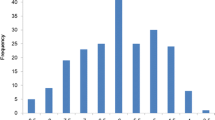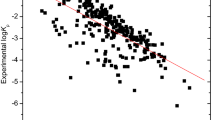Abstract
Quantitative structure–activity relationships (QSAR) have been used to study the skin-irritant effect of 84 thietanes. A suitable set of molecular descriptors was calculated and the important descriptors were selected with the aid of the genetic algorithm and stepwise multiple regression methods. On the basis of principal-components analysis the data set was divided into 67 molecules in a training set and 17 molecules in a test set. The models were validated by use of leave-one-out cross-validation, an external test set, and a Y-randomization test. Comparison of the results obtained indicated the superiority of the genetic algorithm over stepwise multiple regression for feature selection. One GA–MLR model with six selected descriptors was obtained. This model could be used to predict the skin-irritant effect of the thietanes, with high statistical significance (R 2training = 0.897, Q 2LOO = 0.872, Q 2LGO = 0.800, F = 87.253, R 2test = 0.921). The results suggest that the number of bonds in the hydrogen-depleted molecule, electronegativity, mass, and neighbors of carbon atoms are the main independent factors contributing to the skin-irritant effect of the thietanes.
Graphical Abstract







Similar content being viewed by others
References
Draize JH, Woodard G, Calvery HO (1944) J Pharmacol Exp Ther 82:77
Draize JH (1959) Dermal toxicity. Appraisal of the safety of chemicals in foods, drugs, and cosmetics. Association of foods and drugs officials of the United States. Littleton, CO, pp 46–59
Hill DL (1972) The biochemistry and physiology of Tetrahymena, 1st edn. Academic Press, New York
Riahi S, Pourbasheer E, Dinarvand R, Ganjali MR, Norouzi P (2008) Chem Biol Drug Des 72:575
Riahi S, Pourbasheer E, Ganjali MR, Norouzi P (2008) Chem Biol Drug Des 72:205
Riahi S, Ganjali MR, Pourbasheer E, Norouzi P (2008) Chromatographia 6:917
Riahi S, Pourbasheer E, Ganjali MR, Norouzi P (2009) J Hazard Mater 166:853
Khadikar PV, Phadnis A, Shrivastava A (2002) Bioorg Med Chem 10:1181
Agrawal VK, Khadikar PV (2001) Bioorg Med Chem 9:3035
Bratt MD (1996) Toxicol In Vitro 10:247
Golla S, Madihally S, Robinson RL Jr, Gasem KAM (2009) Toxicol In Vitro 23:176
Hayashi M, Nakamura Y, Higashi K, Kato H, Kishida F, Kaneko H (1999) Toxicol In Vitro 13:915
Kodithala K, Hopfinger AJ, Thompson ED, Robinson MK (2002) Toxicol Sci 66:336
Zhang JX, Sun LX, Zhang ZB, Wang ZW, Chen Y, Wang R (2002) J Chem Ecol 28:1287
Shih M, David LL, Lampi KJ, Ma H, Fukiage C, Azuma M, Shearer TR (2001) Curr Eye Res 22:458
Hansch C, Taylor J, Sammes P (1990) Comprehensive medicinal chemistry: the rational design, mechanistic study and therapeutic application of chemical compounds. vol 6. Pergamon, New York, pp 1–19
Tropsha A, Gramatica P, Gombar VK (2003) QSAR Comb Sci 22:69
Todeschini R, Consonni V (2000) Handbook of molecular descriptors. Wiley, Weinheim
Raymond SA, Steffensen SC, Gudino LD, Strichartz GR (1989) Anesth Analg 68:563
Stepanchikova AV, Lagunin AA, Filimonov DA, Poroikov VV (2003) Current Med Chem 10:225
Todeschini R, Consonni V, Pavana M (2002) Dragon, Software version 2.1. http://www.disat.unimib.it/chm/
HyperChem Release 7. HyperCube, Inc, Alberta, Canada; http://www.hyper.com
Hunger J, Huttner G (1999) J Comput Chem 20:455
Ahmad S, Gromiha MM (2003) J Comput Chem 24:1313
Waller CL, Bradley MP (1999) J Chem Inf Comput Sci 39:345
Aires-de-Sousa J, Hemmer MC, Gasteiger J (2002) Anal Chem 74:80
The Mathworks Inc (2002) Genetic algorithm and direct search toolbox users guide, Massachusetts
Gramatica P (2007) QSAR Comb Sci 26:694
Atkinson AC (1985) Plots, transformations and regression: an introduction to graphical methods of diagnostic regression analysis. Clarendon Press, Oxford
Author information
Authors and Affiliations
Corresponding author
Rights and permissions
About this article
Cite this article
Kakoie Dinaki, I., Zarrineh, M. A quantitative structure–activity relationship study of the skin-irritant effect of thietanes. Monatsh Chem 141, 1321–1328 (2010). https://doi.org/10.1007/s00706-010-0405-2
Received:
Accepted:
Published:
Issue Date:
DOI: https://doi.org/10.1007/s00706-010-0405-2




